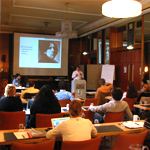Development Of Environmental Infrastructure In The EU: Possibilities For Evaluation
-
-

-
Presentation speakers
- Jurijs Spiridonovs, University of Latvia
- Download presentation
Abstract:
With total financial resources of €347 billion for the 2007-2013 planning period European Cohesion policy is the important topic of research for many both due to huge financial value as well as unprecedented number of participating states, sectors and goals. Present planning period follows previous programming periods, which are described as successful in making difference to standards of living across European Union (European Commission, 2007), not very effective (de la Fuente, 2003) and failed to deliver a satisfactory growth performance (Sapir et al., 2004). Some researchers note that no evidence is found that the policies adopted are the most appropriate (Boldrin, Canova, 2001) and the Cohesion Funds should be terminated with the end of the previous spending cycle (2006) (Boldrin, Canova, 2003). Since the raising awareness on environmental topics and the fact that most of the European states (particularly in EU) as one of the funding priorities mark environmental issues as part of sustainable development strategy, one of the specific issues considered is the impact of the Cohesion policy on environment protection efforts. Present paper discusses different aspects of policy’s impact evaluation with particular accent on possibility to apply counterfactual impact evaluation for environmental infrastructure (e.g. construction of iron removal plants, waste water treatment plants, networks). The research method is comparative and logical analysis of the theoretical concepts, methods and conclusions, published in scientific literature including policy analysis. -
Related Presentations

“Is welfare fair?” A Comparative Study of Migrants‘ Aspirations And Welfare System Support From Germany And Norway
- German Mendzheritskiy

Europe And Its “Accursed“ Share
- Dana Domsodi




















